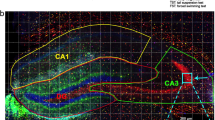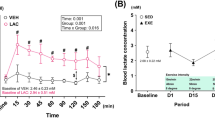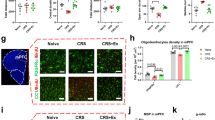Abstract
Exercise has a variety of beneficial effects on brain structure and function, such as hippocampal neurogenesis, mood and memory. Previous studies have shown that exercise enhances hippocampal neurogenesis, induces antidepressant effects and improves learning behavior. Brain serotonin (5-hydroxytryptamine, 5-HT) levels increase following exercise, and the 5-HT system has been suggested to have an important role in these exercise-induced neuronal effects. However, the precise mechanism remains unclear. In this study, analysis of the 5-HT type 3A receptor subunit-deficient (htr3a−/−) mice revealed that lack of the 5-HT type 3 (5-HT3) receptor resulted in loss of exercise-induced hippocampal neurogenesis and antidepressant effects, but not of learning enhancement. Furthermore, stimulation of the 5-HT3 receptor promoted neurogenesis. These findings demonstrate that the 5-HT3 receptor is the critical target of 5-HT action in the brain following exercise, and is indispensable for hippocampal neurogenesis and antidepressant effects induced by exercise. This is the first report of a pivotal 5-HT receptor subtype that has a fundamental role in exercise-induced morphological changes and psychological effects.
This is a preview of subscription content, access via your institution
Access options
Subscribe to this journal
Receive 12 print issues and online access
$259.00 per year
only $21.58 per issue
Buy this article
- Purchase on Springer Link
- Instant access to full article PDF
Prices may be subject to local taxes which are calculated during checkout





Similar content being viewed by others
References
Cotman CW, Berchtold NC, Christie LA . Exercise builds brain health: key roles of growth factor cascades and inflammation. Trends Neurosci 2007; 30: 464–472.
van Praag H . Exercise and the brain: something to chew on. Trends Neurosci 2009; 32: 283–290.
van Praag H, Kempermann G, Gage FH . Running increases cell proliferation and neurogenesis in the adult mouse dentate gyrus. Nat Neurosci 1999; 2: 266–270.
van Praag H, Christie BR, Sejnowski TJ, Gage FH . Running enhances neurogenesis, learning, and long-term potentiation in mice. Proc Natl Acad Sci USA 1999; 96: 13427–13431.
Strawbridge WJ, Deleger S, Roberts RE, Kaplan GA . Physical activity reduces the risk of subsequent depression for older adults. Am J Epidemiol 2002; 156: 328–334.
Ernst C, Olson AK, Pinel JP, Lam RW, Christie BR . Antidepressant effects of exercise: evidence for an adult-neurogenesis hypothesis? J Psychiatry Neurosci 2006; 31: 84–92.
Nabkasorn C, Miyai N, Sootmongkol A, Junprasert S, Yamamoto H, Arita M et al. Effects of physical exercise on depression, neuroendocrine stress hormones and physiological fitness in adolescent females with depressive symptoms. Eur J Public Health 2006; 16: 179–184.
Duman CH, Schlesinger L, Russell DS, Duman RS . Voluntary exercise produces antidepressant and anxiolytic behavioral effects in mice. Brain Res 2008; 1199: 148–158.
Moon HY, Kim SH, Yang YR, Song P, Yu HS, Park HG et al. Macrophage migration inhibitory factor mediates the antidepressant actions of voluntary exercise. Proc Natl Acad Sci USA 2012; 109: 13094–13099.
Anderson BJ, Rapp DN, Baek DH, McCloskey DP, Coburn-Litvak PS, Robinson JK . Exercise influences spatial learning in the radial arm maze. Physiol Behav 2000; 70: 425–429.
van Praag H, Shubert T, Zhao C, Gage FH . Exercise enhances learning and hippocampal neurogenesis in aged mice. J Neurosci 2005; 25: 8680–8685.
Teri L, Gibbons LE, McCurry SM, Logsdon RG, Buchner DM, Barlow WE et al. Exercise plus behavioral management in patients with Alzheimer disease: a randomized controlled trial. J Am Med Assoc 2003; 290: 2015–2022.
Adlard PA, Perreau VM, Pop V, Cotman CW . Voluntary exercise decreases amyloid load in a transgenic model of Alzheimer’s disease. J Neurosci 2005; 25: 4217–4221.
Crizzle AM, Newhouse IJ . Is physical exercise beneficial for persons with Parkinson’s disease? Clin J Sport Med 2006; 16: 422–425.
Goodwin VA, Richards SH, Taylor RS, Taylor AH, Campbell JL . The effectiveness of exercise interventions for people with Parkinson’s disease: a systematic review and meta-analysis. Mov Disord 2008; 23: 631–640.
Greenwood BN, Foley TE, Day HEW, Campisi J, Hammack SH, Campeau S et al. Freewheel running prevents learned helplessness/behavioral depression: role of dorsal raphe serotonergic neurons. J Neurosci 2003; 23: 2889–2898.
Klempin F, Beis D, Mosienko V, Kempermann G, Bader M, Alenina N . Serotonin is required for exercise-induced adult hippocampal neurogenesis. J Neurosci 2013; 33: 8270–8275.
Neeper SA, Gomez-Pinilla F, Choi J, Cotman C . Exercise and brain neurotrophins. Nature 1995; 373: 109.
Vaynman S, Ying Z, Gomez-Pinilla F . Hippocampal BDNF mediates the efficacy of exercise on synaptic plasticity and cognition. Eur J Neurosci 2004; 20: 2580–2590.
Carro E, Trejo JL, Busiguina S, Torres-Aleman I . Circulating insulin-like growth factor 1 mediates the protective effects of physical exercise against brain insults of different etiology and anatomy. J Neurosci 2001; 21: 5678–5684.
Trejo JL, Carro E, Torres-Aleman I . Circulating insulin-like growth factor 1 mediates exercise-induced increases in the number of new neurons in the adult hippocampus. J Neurosci 2001; 21: 1628–1634.
Fabel K, Fabel K, Tam B, Kaufer D, Baiker A, Simmons N et al. VEGF is necessary for exercise-induced adult hippocampal neurogenesis. Eur J Neurosci 2003; 18: 2803–2812.
During MJ, Cao L . VEGF a mediator of the effect of experience on hippocampal neurogenesis. Curr Alzheimer Res 2006; 3: 29–33.
Jacobs BL, van Praag H, Gage FH . Adult brain neurogenesis and psychiatry: a novel theory of depression. Mol Psychiatry 2000; 5: 262–269.
Sahay A, Hen R . Adult hippocampal neurogenesis in depression. Nat Neurosci 2007; 10: 1110–1115.
Zhao C, Deng W, Gage FH . Mechanisms and functional implications of adult neurogenesis. Cell 2008; 132: 645–660.
Moore RY, Halaris AE . Hippocampal innervation by serotonin neurons of the midbrain raphe in the rat. J Comp Neurol 1975; 164: 171–184.
Oleskevich S, Descarries L . Quantified distribution of the serotonin innervation in adult rat hippocampus. Neuroscience 1990; 34: 19–33.
Bliss TVP, Goddard GV, Riives M . Reduction of long-term potentiation in the dentate gyrus of the rat following selective depletion of monoamines. J Physiol 1983; 334: 475–491.
Santarelli L, Saxe M, Gross C, Surget A, Battaglia F, Dulawa S et al. Requirement of hippocampal neurogenesis for the behavioral effects of antidepressants. Science 2003; 301: 805–809.
Airan RD, Meltzer LA, Roy M, Gong Y, Chen H, Deisseroth K . High-speed imaging reveals neurophysiological links to behavior in an animal model of depression. Science 2007; 317: 819–823.
Wang JW, David DJ, Monckton JE, Battaglia F, Hen R . Chronic fluoxetine stimulates maturation and synaptic plasticity of adult-born hippocampal granule cells. J Neurosci 2008; 28: 1374–1384.
Gould E . Serotonin and hippocampal neurogenesis. Neuropsychopharmacology 1999; 21: 46S–51S.
Banasr M, Hery M, Printemps R, Daszuta A . Serotonin-induced increases in adult cell proliferation and neurogenesis are mediated through different and common 5-HT receptor subtypes in the dentate gyrus and the subventricular zone. Neuropsychopharmacology 2004; 29: 450–460.
Klempin F, Babu H, De Pietri Tonelli D, Alarcon E, Fabel K, Kempermann G . Oppositional effects of serotonin receptors 5-HT1a, 2, and 2c in the regulation of adult hippocampal neurogenesis. Front Mol Neurosci 2010; 3: 1–11.
Brunton LL, Lazo JS, Parker KL . Goodman & Gilman’s The Pharmacological Basis of Therapeutics. McGraw-Hill: New York, 2006.
Barnes NM, Sharp T . A review of central 5-HT receptors and their function. Neuropharmacology 1999; 38: 1083–1152.
Meeusen R, Thorre K, Chaouloff F, Sarre S, Meirleir KD, Ebinger G et al. Effects of tryptophan and/or acute running on extracellular 5-HT and 5-HIAA levels in the hippocampus of food-deprived rats. Brain Res 1996; 740: 245–252.
Wilson WM, Marsden CA . In vivo measurement of extracellular serotonin in the ventral hippocampus during treadmill running. Behav Pharmacol 1996; 7: 101–104.
Bequet F, Gomez-Merino D, Berthelot M, Guezennec Y . Exercise-induced changes in brain glucose and serotonin revealed by microdialysis in rat hippocampus: effect of glucose supplementation. Acta Physiol Scand 2001; 173: 223–230.
Gomez-Merino D, Bequet F, Berthelot M, Chennaoui M, Guezennec CY . Site-dependent effects of an acute intensive exercise on extracellular 5-HT and 5-HIAA levels in rat brain. Neurosci Lett 2001; 301: 143–146.
Derkach V, Surprenant A, North RA . 5-HT3 receptors are membrane ion channels. Nature 1989; 339: 706–709.
Maricq AV, Peterson AS, Brake AJ, Myers RM, Julius D . Primary structure and functional expression of the 5HT3 receptor, a serotonin-gated ion channel. Science 1991; 254: 432–437.
Tecott LH, Maricq AV, Julius D . Nervous system distribution of the serotonin 5-HT3 receptor mRNA. Proc Natl Acad Sci USA 1993; 90: 1430–1434.
Morales M, Battenberg E, de Lecea L, Sanna PP, Bloom FE . Cellular and subcellular immunolocalization of the type 3 serotonin receptor in the rat central nervous system. Mol Brain Res 1996; 36: 251–260.
Morales M, Bloom FE . The 5-HT3 receptor is present in different subpopulations of GABAergic neurons in the rat telencephalon. J Neurosci 1997; 17: 3157–3167.
Poncelet M, Perio A, Simiand J, Gout G, Soubrie P, Fur GL . Antidepressant-like effects of SR 57227A, a 5-HT3 receptor agonist, in rodents. J Neural Transm Gen Sect 1995; 102: 83–90.
Staubli U, Xu FB . Effects of 5-HT3 receptor antagonism on hippocampal θ rhythm, memory, and LTP induction in the freely moving rat. J Neurosci 1995; 15: 2445–2452.
Kelly SP, Bratt AM, Hodge CW . Targeted gene deletion of the 5-HT3A receptor subunit produces an anxiolytic phenotype in mice. Eur J Pharmacol 2003; 461: 19–25.
Kondo M, Nakamura Y, Ishida Y, Yamada T, Shimada S . The 5-HT3A receptor is essential for fear extinction. Learn Mem 2014; 21: 740–743.
Zeitz KP, Guy N, Malmberg AB, Dirajlal S, Martin WJ, Sun L et al. The 5-HT3 subtype of serotonin receptor contributes to nociceptive processing via a novel subset of myelinated and unmyelinated nociceptors. J Neurosci 2002; 22: 1010–1019.
Bachy A, Heaulme M, Giudice A, Michaud JC, Lefevre IA, Souilhac J et al. SR 57227A: a potent and selective agonist at central and peripheral 5-HT3 receptors in vitro and in vivo. Eur J Pharmacol 1993; 237: 299–309.
Kondo M, Takei Y, Hirokawa N . Motor protein KIF1A is essential for hippocampal synaptogenesis and learning enhancement in an enriched environment. Neuron 2012; 73: 743–757.
Franklin KBJ, Paxinos G . The Mouse Brain in Stereotaxic Coordinates, 3rd edn Academic Press: New York, 2007.
David JD, Samuels BA, Rainer Q, Wang JW, Marsteller D, Mendez I et al. Neurogenesis-dependent and -independent effects of fluoxetine in an animal model of anxiety/depression. Neuron 2009; 62: 479–493.
Rainer Q, Xia L, Guilloux JP, Gabriel C, Mocaer E, Hen R et al. Beneficial behavioural and neurogenic effects of agomelatine in a model of depression/anxiety. Int J Neuropsychopharmacol 2012; 15: 321–335.
Tanti A, Belzung C . Neurogenesis along the septo-temporal axis of the hippocampus: are depression and the action of antidepressants region-specific? Neuroscience 2013; 252: 234–252.
Castagne V, Moser P, Roux S, Porsolt RD . Rodent models of depression: forced swim and tail suspension behavioral despair tests in rats and mice. Curr Protoc Neurosci 2011; 55: 8.10A.1–8.10A.14.
Bednarczyk MR, Aumont A, Decary S, Bergeron R, Fernandes KJL . Prolonged voluntary wheel-running stimulates neural precursors in the hippocampus and forebrain of adult CD1 mice. Hippocampus 2009; 19: 913–927.
Liu J, Somera-Molina KC, Hudson RL, Dubocovich ML . Melatonin potentiates running wheel-induced neurogenesis in the dentate gyrus of adult C3H/HeN mice hippocampus. J Pineal Res 2013; 54: 222–231.
van Praag H, Schinder AF, Christie BR, Toni N, Palmer TD, Gage FH . Functional neurogenesis in the adult hippocampus. Nature 2002; 415: 1030–1034.
Baruch DE, Swain RA, Helmstetter FJ . Effects of exercise on Pavlovian fear conditioning. Behav Neurosci 2004; 118: 1123–1127.
Greenwood BN, Strong PV, Foley TE, Fleshner M . A behavioral analysis of the impact of voluntary physical activity on hippocampus-dependent contextual conditioning. Hippocampus 2009; 19: 988–1001.
Kempermann G, Kuhn HG, Gage FH . More hippocampal neurons in adult mice living in an enriched environment. Nature 1997; 386: 493–495.
Malberg JE, Eisch AJ, Nestler EJ, Duman RS . Chronic antidepressant treatment increases neurogenesis in adult rat hippocampus. J Neurosci 2000; 20: 9104–9110.
Sahay A, Scobie KN, Hill AS, O’Carrol CM, Kheirbek MA, Burghardt NS et al. Increasing adult hippocampal neurogenesis is sufficient to improve pattern separation. Nature 2011; 472: 466–470.
Schloesser RJ, Lehmann M, Martinowich K, Manji HK, Herkenham M . Environmental enrichment requires adult neurogenesis to facilitate the recovery from psychosocial stress. Mol Psychiatry 2010; 15: 1152–1163.
Bruel-Jungerman E, Laroche S, Rampon C . New neurons in the dentate gyrus are involved in the expression of enhanced long-term memory following environmental enrichment. Eur J Neurosci 2005; 21: 513–521.
Meshi D, Drew MR, Saxe M, Ansorge MS, David D, Santarelli L et al. Hippocampal neurogenesis is not required for behavioral effects of environmental enrichment. Nat Neurosci 2006; 9: 729–731.
Jiang W, Zhang Y, Xiao L, Van Cleemput J, Ji SP, Bai G et al. Cannabinoids promotes embryonic and adult hippocampus neurogenesis and produce anxiolytic- and antidepressant-like effects. J Clin Invest 2005; 115: 3104–3116.
Li Y, Luikart BW, Birnbaum S, Chen J, Kwon CH, Kernie SG et al. TrkB regulates hippocampal neurogenesis and governs sensitivity to antidepressive treatment. Neuron 2008; 59: 399–412.
Schmidt-Hieber C, Jonas P, Bischofberger J . Enhanced synaptic plasticity in newly generated granule cells of the adult hippocampus. Nature 2004; 429: 184–187.
Eadie BD, Redila VA, Christie BR . Voluntary exercise alters the cytoarchitecture of the adult dentate gyrus by increasing cellular proliferation, dendritic complexity, and spine density. J Comp Neurol 2005; 486: 39–47.
Redila VA, Christie BR . Exercise-induced changes in dendritic structure and complexity in the adult hippocampal dentate gyrus. Neuroscience 2006; 137: 1299–1307.
Dietrich MO, Andrews ZB, Horvath TL . Exercise-induced synaptogenesis in the hippocampus is dependent on UCP2-regulated mitochondrial adaptation. J Neurosci 2008; 28: 10766–10771.
Moser MB, Moser EI . Functional differentiation in the hippocampus. Hippocampus 1998; 8: 608–619.
Fanselow MS, Dong HW . Are the dorsal and ventral hippocampus functionally distinct structures? Neuron 2010; 65: 7–19.
Kheirbek MA, Hen R . Dorsal vs ventral hippocampal neurogenesis: implications for cognition and mood. Neuropsychopharmacology 2011; 36: 373–374.
Gage FH, Thompson RG . Differential distribution of norepinephrine and serotonin along the dorsal-ventral axis of the hippocampal formation. Brain Res Bull 1980; 5: 771–773.
Bjarkam C, Sorensen JC, Geneser FA . Distribution and morphology of serotonin-immunoreactive axons in the hippocampal region of the New Zealand white rabbit. I. Area dentate and hippocampus. Hippocampus 2003; 13: 21–37.
Banasr M, Soumier A, Hery M, Mocaer E, Daszuta A . Agomelatine a new antidepressant, induces regional changes in hippocampal neurogenesis. Biol Psychiatry 2006; 59: 1087–1096.
Boldrini M, Underwood MD, Hen R, Rosoklija GB, Dwork AJ, Mann JJ et al. Antidepressants increase neural progenitor cells in the human hippocampus. Neuropsychopharmacology 2009; 34: 2376–2389.
Acknowledgements
This work was supported by JSPS KAKENHI grant number 26860926, and grants from the Uehara Memorial Foundation, the Japan Prize Foundation, Brain Science Foundation, the Sakamoto Research Foundation of Psychiatric Diseases, Takeda Science Foundation, the Ichiro Kanehara Foundation, Kanae Foundation, Suzuken Memorial Foundation and Meiji Yasuda Life Foundation. We thank Shingo Miyata (Kinki University) for technical assistance.
Author information
Authors and Affiliations
Corresponding author
Ethics declarations
Competing interests
The authors declare no conflict of interest.
Additional information
Supplementary Information accompanies the paper on the Molecular Psychiatry website
Supplementary information
Rights and permissions
About this article
Cite this article
Kondo, M., Nakamura, Y., Ishida, Y. et al. The 5-HT3 receptor is essential for exercise-induced hippocampal neurogenesis and antidepressant effects. Mol Psychiatry 20, 1428–1437 (2015). https://doi.org/10.1038/mp.2014.153
Received:
Revised:
Accepted:
Published:
Issue Date:
DOI: https://doi.org/10.1038/mp.2014.153
This article is cited by
-
Complicated Role of Exercise in Modulating Memory: A Discussion of the Mechanisms Involved
Neurochemical Research (2022)
-
Exercise ameliorates aberrant synaptic plasticity without enhancing adult-born cell survival in the hippocampus of serotonin transporter knockout mice
Brain Structure and Function (2021)
-
Renoprotective and neuroprotective effects of enteric hydrogen generation from Si-based agent
Scientific Reports (2020)
-
Psychological health, sleep quality, and coping styles to stress facing the COVID-19 in Wuhan, China
Translational Psychiatry (2020)
-
Bladder urothelium converts bacterial lipopolysaccharide information into neural signaling via an ATP-mediated pathway to enhance the micturition reflex for rapid defense
Scientific Reports (2020)



